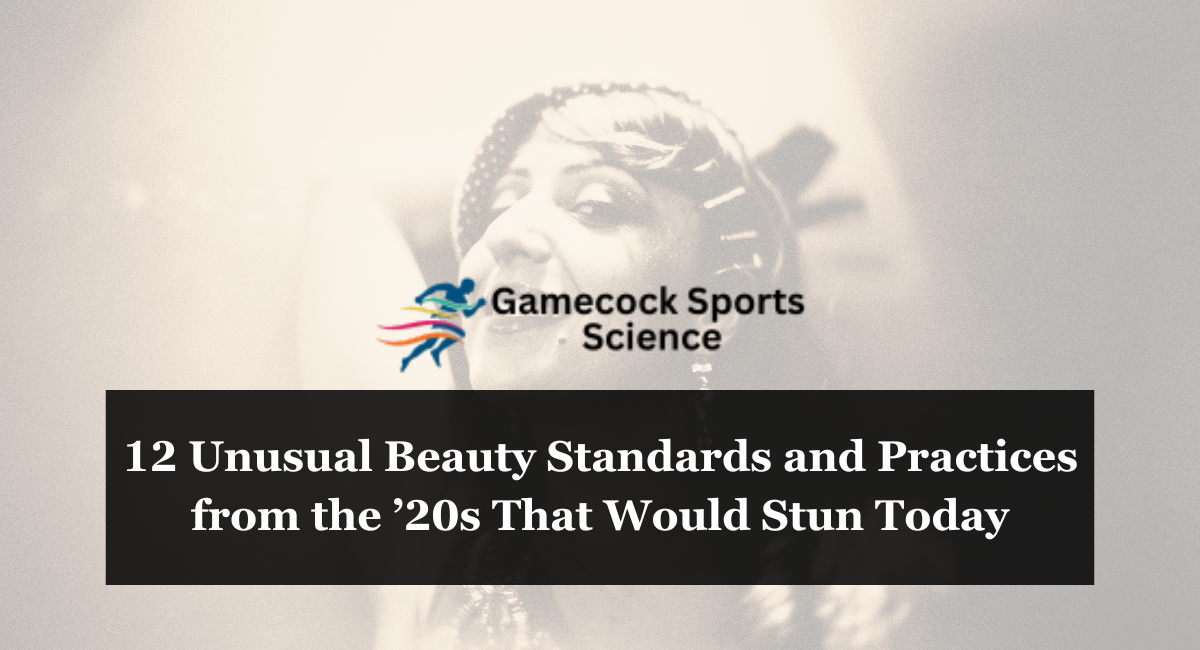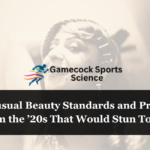The 1920s, also known as the “Roaring Twenties,” were a time of immense social and cultural change. Women embraced newfound freedoms, fashion shed its Victorian constraints, and a new definition of beauty emerged.
However, compared to today’s standards, some beauty trends of the era would leave us wide-eyed and speechless. Let’s delve into 12 unusual beauty practices and trends from the 1920s that would surely stun us today.
The Brow Rebellion: From Full to Feathery
Eyebrows today are celebrated in all their natural glory, but the 1920s were all about dramatic change. Here’s what went down:
Tweezer Frenzy: Gone were the bushy brows of the Victorian era. Women meticulously plucked their eyebrows into thin, feathery lines, often following a high arch shape. This trend aimed to create a look of wide-eyed innocence and sophistication.
The Stencil Solution: Arrow stencils were all the rage for those lacking natural arch skills. These stencils helped achieve the desired thin, arched brow shape with minimal plucking mishaps.
Today, we appreciate a fuller, more natural brow, making the ultra-thin lines of the 1920s appear almost comical.
The Rouge Rage: A High-Cheekbone Obsession
Cheekbones are a coveted facial feature today, but the 1920s approach to highlighting them was unique:
High and Mighty Blush: Blush wasn’t applied to the apples of the cheeks as we do today. Instead, women used a dramatic application high on the cheekbones, often extending towards the temples. This created a sharp, almost gaunt appearance.
The Rouge Palette: Gone were the rosy pinks and peaches. The color palette of the era leaned towards bold reds, plums, and even oranges for blush, creating a dramatic and somewhat theatrical look.
Today’s blush application focuses on a natural flush, making the high and harsh placement of the 1920s look jarring to modern eyes.
The Charleston Complexion: The Paler, the Better
Sun-kissed skin is a modern ideal, but the 1920s worshipped a different kind of glow:
Pale is the Rage: A tanned complexion was considered working-class or unfashionable. The ideal was a pale, almost ghostly complexion achieved with heavy white face powder.
The Lead Danger: Unfortunately, many face powders of the era contained lead, a toxic substance. The pursuit of pale skin could come at a dangerous cost to health.
The Flapper Fringe: A Haircut Fit for a Flapper
Hairstyles underwent a dramatic shift in the 1920s, mirroring the changing role of women in society:
The Bob is Born: Long, flowing hair was out. The “bob,” a short haircut reaching the chin or jawline, symbolized liberation and rebellion against traditional feminine hairstyles.
Fringe Frenzy: The bob was often paired with a dramatic fringe, adding a touch of playfulness and youthfulness to the look. This iconic hairstyle became synonymous with the flapper era.
The bob haircut remains a popular choice today, but the dramatic fringe of the 1920s might appear too blunt for modern sensibilities.
The Kiss Me Quick Cupid’s Bow: A Decade of Bold Lips
Lips are a significant focus in modern makeup, but the 1920s had a particular idea of the perfect pout:
The Cupid’s Bow Craze: The desired shape was a small, defined upper lip, often accentuated with a darker shade of lipstick. This created a heart-shaped effect, mimicking the mythical Cupid’s bow.
Berry Bold: Gone were the natural lip colors. The 1920s embraced bold berry shades like red, plum, and black to create a dramatic, statement-making lip.
Today, lip shapes and colors are celebrated in all their diversity. The focus on a tiny upper lip and the dramatic shades of the 1920s might seem too theatrical for modern makeup preferences.
The Stenciled Beauty Mark: A Touch of Allure (or Mischief?)
Beauty marks have always held a certain mystique, and the 1920s took this fascination to a new level:
The Allure of the Artificial: Natural beauty marks were considered lucky, but not everyone had them. The solution? Stenciled beauty marks! These were applied strategically on the face to add a touch of allure or perhaps a hint of mischief.
Placement is Key: The placement of the beauty mark varied, but common spots included above the lip, on the cheekbone, or near the eye. These strategically placed marks added a touch of drama and intrigue to the flapper’s face.
Today, beauty marks are seen as a unique feature, not something to be artificially created. Using stencils in the 1920s adds a touch of the theatrical to this beauty trend.
The Eyelash Experiment: From Clumps to Coals
Eyelashes are a significant focus in modern makeup, but the 1920s approach to enhancing them was, well, interesting:
As we know, the Clumpy Lash Mascara wasn’t readily available in the 1920s. Instead, women used petroleum jelly, kohl, or even burnt cork to darken and clump their lashes together. This often resulted in a spidery, unnatural appearance.
The False Lash Forerunner: For a more dramatic look, some women use false eyelashes made of feathers or even human hair! These were often uncomfortable and impractical, but the desire for bold lashes prevailed.
The Rouge Lips: Staining for Lasting Color
Long-lasting lipsticks are a modern marvel, but the 1920s had their own somewhat concerning, solution:
The Staining Power of Tinctures: Long-lasting lipsticks, as we know them, don’t exist yet. To achieve a lasting red stain, women sometimes resorted to using harsh chemicals like mercuric sulfide or even beet juice!
These practices were not only ineffective but also dangerous.
The Price of Beauty: Pursuing a bold red lip could cost a lot. The harsh chemicals used for staining could lead to lip irritation, discoloration, and permanent damage.
Modern science has provided us with safe and effective, long-lasting lipsticks. The dangerous staining methods of the 1920s serve as a stark reminder to prioritize safety over extreme beauty ideals.
The Eyebrow Tattoo: A Permanent (and Potentially Regretful) Choice
Eyebrow tattoos are a growing trend today, but the 1920s offered a much cruder version:
Permanent Ink: A more permanent solution exists for those tired of daily tweezing and stenciling: eyebrow tattoos! These tattoos were often poorly done, resulting in unnatural and sometimes even comical-looking brows.
Regret in Ink: In the 1920s, with limited tattoo removal options, a poorly executed eyebrow tattoo could be a permanent source of regret. Imagine being stuck with bright blue or green eyebrows for life!
Modern eyebrow tattoo techniques offer far greater precision and control. Thankfully, the potential for eyebrow tattoo disasters of the 1920s is a thing of the past.
Today, we have a variety of safe and effective mascaras and comfortable false lashes. The clumpy, unnatural lashes of the 1920s seem like a far cry from the fluttery, defined lashes we aim for today.
The Freckle Frenzy: From Flaw to Fashion Statement
Freckles are often seen as a natural beauty feature today, but the 1920s had a different take:
Faux Freckles for All: For those lacking the natural sprinkle of freckles, achieving them artificially became a trend. Women used pencils or even chemicals to create a smattering of fake freckles across their noses and cheeks.
The Allure of Imperfection: Freckles, once considered a flaw, were seen as adding a touch of youthful charm and innocence. This trend highlights the ever-shifting perception of beauty throughout history.
Today, freckles are embraced as a natural feature. The deliberate creation of fake freckles in the 1920s seems counterintuitive to our modern appreciation of natural beauty.
The Pointed Chin Craze: A Quest for Sharp Features
A defined jawline is a desired feature today, but the 1920s approach to achieving it was somewhat extreme:
Makeup Magic (or Maybe Mischief): Women used makeup techniques like contouring with darker shades to create the illusion of a sharper chin. However, some resorted to more drastic measures, such as applying pressure bandages or adhesive tape to manipulate the jawline!
Comfort at a Cost: These extreme methods were uncomfortable and potentially harmful, putting unnecessary strain on the facial muscles.
Modern makeup techniques offer safe and effective ways to enhance facial features. The uncomfortable and potentially risky methods of the 1920s serve as a reminder to prioritize comfort and safety over extreme beauty ideals.
The Height of Fashion: Elevated Shoes with Questionable Comfort
High heels are a classic footwear choice, but the 1920s took heel heights to new and sometimes impractical extremes:
The Dangers of the Dizzying Drop: In the 1920s, heels could reach astonishing heights, often exceeding 4 inches. These sky-high shoes were complex to walk in and posed a significant risk of ankle sprains and falls.
Fashion Over Function: Comfort was sacrificed to pursue a fashionable silhouette. The Charleston dance, a popular era craze, was likely even more challenging in these precarious heels!
The 1920s were a time of innovation and experimentation in beauty. While some trends have stood the test of time, others offer a glimpse into a bygone era of beauty ideals.
From the pursuit of pale skin to the dramatic use of blush and rouge, these unusual beauty practices remind us of the ever-evolving definition of beauty throughout history.










